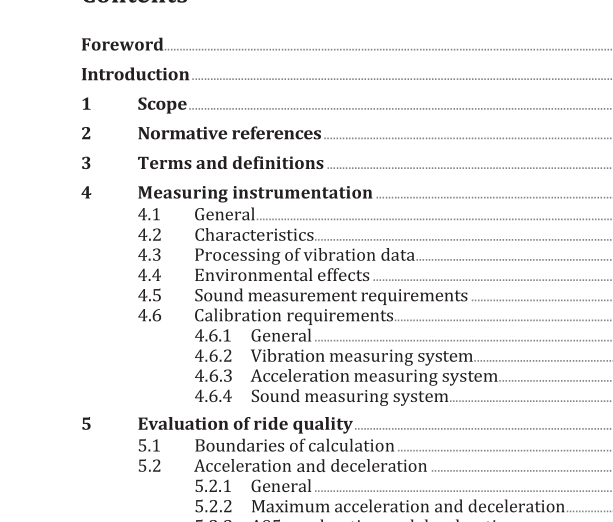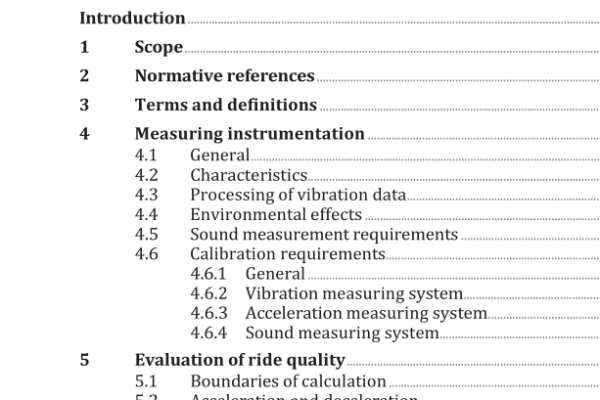ISO 8100-34:2021 pdf download – Lifts for the transport of persons and goods — Part 34: Measurement of lift ride quality.
3.2 vibration variation with time of the magnitude of acceleration, when the magnitude is alternately greater and smaller than a reference level Note 1 to entry: It is expressed in metres per second squared (m/s ). Note 2 to entry: The deprecated unit Gal (Galileo) is sometimes used: 1 Gal = 0,01 m/s . 3.3 A95 value of acceleration (3.1) or vibration (3.2), within defined boundaries or limits, which 95 % of found values are equal to or less than Note 1 to entry: This value is used statistically to estimate typical levels. Note 2 to entry: See 5.2.3 , 5.4.1 and 5.4.3 . 3.4 velocity rate of change of z -axis displacement, attributed to lift motion control Note 1 to entry: Velocity is reported as speed and direction of travel. It is given in metres per second (m/s). 3.5 V95 value of velocity (3.4), within defined boundaries or limits, which 95 % of found values are equal to or less than Note 1 to entry: This value is used statistically to estimate typical levels. Note 2 to entry: See 5.5.3. 3.6 x-axis, y-axis, z-axis axes of measurement orthogonal reference axes for the measurements Note 1 to entry: to entry: For lifts of conventional configuration, x is the perpendicular to the plane of the car front door (i.e. back to front), y is the perpendicular to x and z (i.e. side to side) and z is the perpendicular to the car floor (i.e. vertical). Note 2 to entry: For lifts of unconventional configuration, the axes should be defined for directions of basicentric coordinate systems for mechanical vibrations influencing human subjects, for a standing person facing the front car door, in accordance with ISO 2631-1. 3.7 lift ride quality sound levels in the car, and vibration of the car floor, relevant to passenger perception, associated with lift motion 3.8 jerk rate of change of z -axis acceleration (3.1), attributed to lift motion control Note 1 to entry: The passenger perception of vertical ride quality during jerk is represented by the assessment of vertical vibration during non-constant acceleration. See 5.3 and 5.4.3 . Note 2 to entry: Jerk is expressed in metres per second cubed (m/s ).4.3 Processing of vibration data Vibration data shall be weighted in accordance with ISO 8041 to simulate the human body’s response to vibration. The vibration signals shall be frequency weighted with the whole body x, y and z weighting factors and band limiting as defined in ISO 8041. For digital sampling systems, uncompressed data shall be used. 4.4 Environmental effects The instrumentation shall be in accordance with the criteria for mechanical vibration, temperature range and humidity range specified in ISO 8041. 4.5 Sound measurement requirements The sound measuring system shall be in accordance with the requirements for Class 2 sound level meters as specified in IEC 61672-1. 4.6 Calibration requirements 4.6.1 General All instrumentation calibrations shall be traceable to metrological national standards. The measurement system shall be calibrated before first use, and following any major repairs or modifications likely to affect the calibration. 4.6.2 Vibration measuring system Calibration shall include determination of the reading error for sinusoidal input at 8 Hz and at five or more other frequencies approximately equally spaced between 0,1 Hz and 80 Hz, with acceleration amplitudes not less than 0,1 m/s . Calibration shall be in accordance with ISO 8041.
ISO 8100-34:2021 pdf download – Lifts for the transport of persons and goods — Part 34: Measurement of lift ride quality






